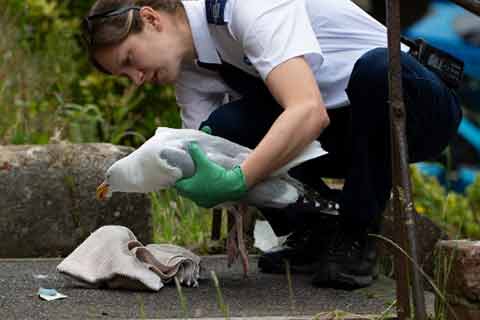Acorn and sycamore poisoning in animals
Acorns, sycamore seeds and seedlings are poisonous to some farm animals, horses and pets. If you're concerned about poisoning - don't wait for symptoms to appear - consult your vet immediately.
If farm animals (cattle, sheep and goats), horses or dogs eat acorns during autumn or young oak leaves during spring, symptoms can appear within hours or after several days.
Common signs of acorn poisoning
Symptoms of poisoning may vary between species but often include:
- Vomiting and diarrhoea
- Abdominal tenderness
- Tiredness
- Depression
- Rapid weight loss
- Loss of appetite
- Dehydration
- Colic
- Weakness
- Head pressing
- Uncoordinated movements
Dog owners
We understand it's difficult to watch your dog's every movement. However, if owners think their dog will show interest in or eat acorns, they should find a safer place to take their dog. Owners can also bring a toy or tasty treat so their pet can be easily distracted and recalled.
Farmers and horse owners
Farmers and horse owners should ensure food doesn't get too short in fields with oak trees. Animals are unlikely to gorge on anything dangerous if food is readily available. However, some horses develop a taste for acorns and oak leaves and will seek them out.
As well as acorns, sycamore seedlings and the 'helicopter' seeds can be fatal to horses. Farmers and horse owners should monitor their animals. They shouldn't have access to poisonous trees, however, if any are eating acorns or sycamore seeds, move them to a different field or fence around the trees. Beware - sycamore seeds and seedlings can spread over 100 metres away.
Common signs of sycamore poisoning
Symptoms can show very quickly in horses:
- Trembling
- Lethargy
- Stiffness
- Sweating
- Difficulty breathing
- Sudden death
If you're concerned
Find out more common pet poisons.
Keeping pets safe in the dark
Just as you should always wear reflective clothing to make yourself visible when walking near roads in the dark, don't forget your pets! Fit your dog and cat with a reflective collar - but make sure you only use a quick release collar for a cat.
Animals on the roads
As the nights grow longer, we see more injured wild animals coming into our care who've been involved in road traffic accidents. Accidents involving deer are especially common during the rut, which can occur from mid-July to December (depending on the species).
Take note of warning signs, drive with extreme caution (especially early morning and evening) and report collisions with deer to the police.
Grey seal pups on the beach
September to December is the breeding season for grey seals. Pups are born with a fluffy white coat and don't enter the sea for the first two to three weeks. Don't approach a seal pup on its own, or allow dogs or other animals to harass them, as they can give a nasty bite - and if a seal pup is scared into the water, it could be washed out to sea and get lost.
Fireworks and bonfires during the festive season
If possible build bonfires close to the time of lighting and check them thoroughly for animals before lighting. This can help save the lives of hedgehogs and other small animals.
Loud fireworks can be terrifying for animals, but there are things you can do to help them cope. Find out more about animals and fireworks.
Feeding leftover pumpkins to animals
Pumpkin flesh and seeds can be used to make tasty meals and treats for us to enjoy. However, sadly they’re dangerous for some wildlife, such as hedgehogs.
If you have any leftovers, please don’t leave them on the ground.
When offered safely off the ground in bird feeders, birds can enjoy freshly cut sections of pumpkin and seeds. Make sure to remove anything that isn’t eaten quickly so it doesn't get mouldy or attract rodents.
After you and the birds have had your fill, compost pumpkins safely if you’re able, or leave them in your food waste collection.
It’s illegal to feed farmed animals, such as pet pigs and backyard chickens, any kitchen waste, including pumpkins.
Fleas in your home
Fleas are more commonly associated with the summer months, but did you know your home can provide the perfect breeding ground in autumn? Turning up your heating in the autumn to between 21 and 25 degrees Celsius can cause dormant flea pupae to hatch into adults.
It's important to treat your pet for fleas regularly all year round, as even if there are no signs of fleas in your home your pet may have a chance to catch them. Our FleaAway treatment will protect your pets from fleas, but make sure you also treat your home with a household flea spray (follow the instructions carefully). Flea pupae like dark, warm spots, so make sure you treat all floors, under sofas and beds and even spray a small amount in your hoover.
Hibernating bats
Bats look for suitable hibernation sites around October. Pipistrelles are the most likely to roost in buildings during winter. Bats and their roosts are protected by law in the UK - so you mustn't disturb or harm them in any way. Find out more about bats and the law.
Follow the links below for more seasonal advice on keeping animals safe and happy at different times of the year.
Sign up to our newsletter for more ways to help animals
Our monthly newsletter is packed full of pet care advice, hints and tips on helping wildlife, our latest news, rehoming success stories and more.




